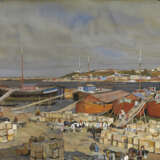ID 70684
Lot 19 * | YUON, KONSTANTIN (1875-1958) On the Volga, Unloading a Barge , signed.
Valeur estimée
£ 100 000 – 200 000
Provenance: Important private collection, Europe.
Authenticity of the work has been confirmed by the expert V. Petrov.
Authenticity has also been confirmed by the expert E. Zhukova.
Exhibited: IX vystavka kartin Soiuza russkikh khudozhnikov, Moscow, St Petersburg, 1911–1912.
Literature: Exhibition catalogue, Katalog IX vystavki kartin Soiuza russkikh khudozhnikov, Moscow, 1911, No. 446, listed.
Exhibition catalogue, Katalog IX vystavki kartin Soiuza russkikh khudozhnikov, St Petersburg, 1912, No. 396, listed.
N. Tretiakov, Konstantin Fedorovich Yuon, Moscow, Iskusstvo, 1957, p. 104, listed under the works from 1911 as Razgruzka barzhi. Na Nizhegorodskoi iarmarke.
V. Lapshin, Soiuz russkikh khudozhnikov, Leningrad, Khudozhnik RSFSR, 1974, p. 232, listed.
One of the most optimistic Russian artists of the early 20th century, Konstantin Yuon had been captivated by the subject of the great Russian river Volga since his early youth. He first embarked on a journey along the Volga in search for the inspiration for his work immediately after graduating from the Moscow School of Painting, Sculpture and Architecture. Later, he often travelled upstream, stopping at various towns on the upper reaches of the Volga, where he was attracted by the well-preserved provincial way of life, “the wonderful bright colours of the painted cottages” and the beautiful landscapes of the river banks.
The painting On the Volga, Unloading a Barge presented here for auction belongs to a series of gouaches and watercolours influenced by Yuon’s impressions from the journey to Nizhny Novgorod in 1911. The trip proved very productive for the artist, with a series of Novgorod views and Volga landscapes appearing soon after its completion. The artist’s attention was particularly drawn to the market places, jetties and bridges, bustling and full of life, where the Volga was a continuation of urban space, its banks seething with the busy daily activities of a river port. The artist was captivated by the breadth, the openness and the sheer verve of the region around Nizhny Novgorod, and many of his landscapes from this series — Volga Jetties in Nizhny Novgorod (1911, Museum-Apartment of I. Brodsky, St Petersburg), Samolet Jetty on the Volga (1911), Jetty on the Volga (1912, Serpukhov Historical and Art Museum), Sunset on the Volga. Nizhny Novgorod (1911, Nizhny Novgorod State Museum of Art) — resemble vast panoramas. To capture the expanses of the Volga as fully as possible, Yuon selects a high viewpoint for the landscape, taking in the river bank in a single view, with its great bustle of people and carts, steam boats ready to leave with crowds of impatient passengers, the smooth blue waters of the river flashing in the sun, and the town visible in the distance. “I wanted to create these pictures like songs”, the artist recalled.
On the Volga, Unloading a Barge is one of these lively Volga panoramas bursting with life. Before us is a view of the riverbank, a jetty, the Volga, and a summer sky covered with grey rain clouds. The water of the river is of a dense leaden colour, and this motionless smooth surface, passing away around a bend, is visible right to the distant line of horizon. But the river, the sky and the opposite bank of the river clustered with buildings are only the background against which the pictorial narrative of an ordinary day on a Volga jetty unfolds. The space is filled with heavy barges, laden with containers, people and carts waiting for cargo. Hauliers bustle along a high gangway, and carts move incessantly in every direction.
| Adresse de l'enchère |
MacDougall Arts Ltd. 63 New Cavendish St. W1G 7LP London Royaume-Uni | |
|---|---|---|
| Aperçu |
| |
| Téléphone | +44 20 7389 8160 | |
| Téléphone | +7 495 799 4683 | |
| Fax | +44 (0) 20 7389 8170 | |
| Conditions d'utilisation | Conditions d'utilisation | |
| transport |
Service postal Service de messagerie ramassage par vous-même | |
| Modes de paiement |
Virement bancaire |




